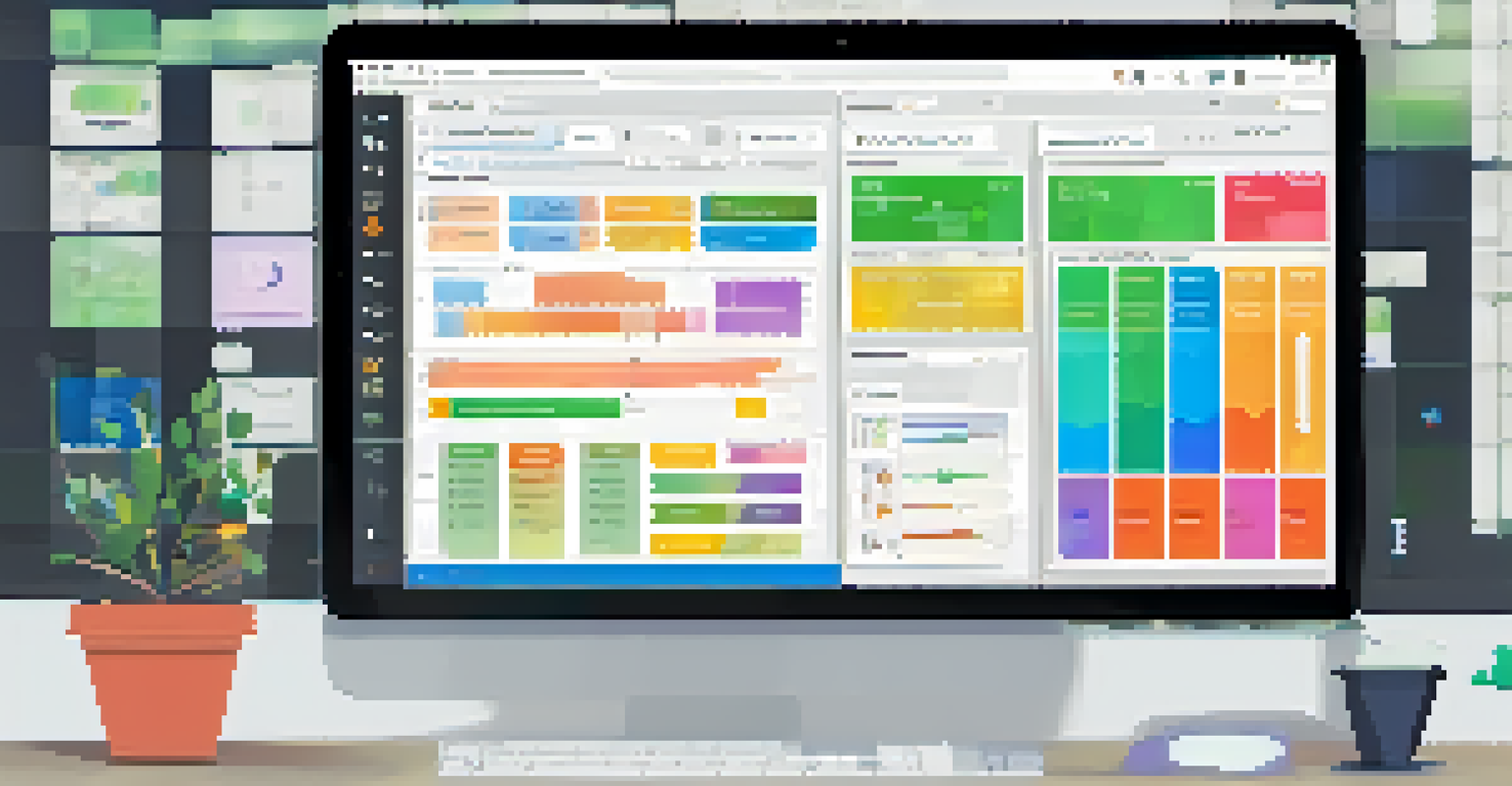How Low-Code Development Enhances Team Collaboration

Understanding Low-Code Development and Its Benefits
Low-code development is a visual approach to creating applications that requires minimal coding. It allows team members, regardless of their technical skill level, to participate in the development process. This democratization of app development leads to faster project completion and reduces the bottlenecks often caused by traditional coding methods.
The best way to predict the future is to create it.
With low-code platforms, teams can quickly prototype and iterate on ideas. This agility is crucial in today’s fast-paced business environment, where the ability to adapt and respond to changes can make or break a project. For example, a marketing team can collaborate directly with developers to create tools that enhance their campaigns, all without needing deep programming knowledge.
Ultimately, low-code development empowers teams to work more efficiently together, ensuring that everyone’s input is valued. By breaking down the barriers between technical and non-technical roles, organizations can foster a more inclusive and innovative culture. This collaboration can lead to greater creativity and ultimately better products.
Bridging the Gap Between IT and Business Teams
One of the most significant challenges in any organization is the disconnect between IT and business teams. Low-code development serves as a bridge, allowing these two groups to collaborate more effectively. When business users can create their own applications with minimal IT support, it reduces the dependency on developers for every small change.

This newfound ability to build applications enables business professionals to express their needs directly, leading to solutions that align closely with their objectives. For instance, a sales team can quickly develop a customer relationship management tool tailored to their specific processes without waiting for lengthy IT cycles. This direct involvement enhances satisfaction on all fronts.
Empowering Collaboration Across Teams
Low-code development bridges the gap between IT and business teams, enabling greater collaboration and faster project delivery.
Furthermore, having IT involved in the platform's governance ensures that applications remain secure and compliant with company standards. This collaboration not only enhances productivity but also fosters a sense of shared ownership among teams, paving the way for more cohesive project outcomes.
Enhancing Communication Through Visual Tools
Visual tools are at the heart of low-code development, providing an intuitive interface for users to design applications. By using drag-and-drop features, team members can easily visualize their ideas, making it simpler to communicate concepts and requirements. This clarity can significantly reduce misunderstandings and misalignments during the development process.
Innovation distinguishes between a leader and a follower.
For example, when a project team can see the layout of an application in real-time, they can provide immediate feedback and suggest changes on the spot. This iterative process fosters open dialogue and ensures that everyone’s voice is heard. As a result, the final product reflects a more collaborative effort rather than a series of isolated contributions.
By enhancing communication through these visual tools, teams can maintain momentum and focus on delivering value. This approach not only streamlines the development process but also builds camaraderie among team members who see their contributions come to life.
Fostering a Culture of Innovation and Experimentation
Low-code development encourages a culture of innovation by allowing teams to experiment without the fear of failure. Team members can quickly test new ideas and features in a low-risk environment, resulting in a more agile and creative workplace. This freedom to explore can lead to breakthrough ideas that may not have emerged in a more traditional development setting.
When teams feel empowered to innovate, they are more likely to take initiative and propose new projects. For instance, a customer support team might develop an application to streamline ticket management based on their unique experiences. This proactive mindset can lead to continuous improvement across the organization.
Enhancing Communication and Feedback
Visual tools in low-code platforms facilitate clear communication and rapid feedback loops, leading to more effective project outcomes.
Moreover, this culture of experimentation often spills over into other areas of the business, inspiring a more dynamic approach to problem-solving. By embracing low-code development, organizations cultivate an environment where innovation thrives, ultimately driving growth and success.
Improving Project Transparency and Accountability
Transparency is crucial in any collaborative effort, and low-code development platforms often include features that enhance visibility into the project lifecycle. These tools allow teams to monitor progress, track changes, and hold each other accountable for their contributions. This level of transparency builds trust and ensures that everyone is aligned with the project goals.
For example, team members can easily access dashboards that display the status of various tasks, allowing them to see how their work fits into the larger picture. This visibility not only helps in managing timelines but also fosters a sense of collective responsibility. When everyone knows their role and how it impacts the project, collaboration becomes more effective.
Additionally, regular updates and shared progress reports can spark more meaningful discussions during team meetings. This structured communication helps teams stay focused and engaged, ultimately leading to successful project outcomes.
Facilitating Rapid Feedback Loops
One of the standout features of low-code development is the ability to implement rapid feedback loops. As applications are built, team members can provide feedback almost in real-time, allowing for swift adjustments. This iterative process helps ensure that the final product meets the needs of all stakeholders, enhancing overall satisfaction.
For instance, during the development of a new internal tool, a finance team might discover a need for additional features midway through the project. With low-code platforms, they can quickly communicate these needs, and developers can implement changes without significant delays. This responsiveness is essential in maintaining momentum.
Fostering Innovation and Skill Growth
Low-code environments encourage experimentation and skill development, creating a culture of innovation within organizations.
These rapid feedback loops not only improve the quality of the application but also enhance team morale. When team members see that their input is valued and acted upon, they are more likely to engage actively in future projects, fostering a cycle of continuous improvement.
Streamlining Onboarding and Skill Development
Low-code development platforms are user-friendly, which makes them an excellent tool for onboarding new team members. With minimal training, new hires can start contributing to projects almost immediately. This ease of use not only accelerates the onboarding process but also allows for a smoother transition into the team dynamics.
Additionally, as team members use low-code tools, they naturally develop new skills. The hands-on experience gained through building applications can enhance their understanding of both technical and business aspects. Over time, this skill development can lead to a more versatile and capable workforce.

As teams grow and evolve, the ability to quickly adapt to new technologies becomes crucial. Low-code platforms empower team members to stay agile and equipped with the necessary skills to meet changing demands. This ongoing learning contributes to a more innovative and resilient organization.
Conclusion: Embracing Low-Code for Better Collaboration
In conclusion, low-code development is transforming the way teams collaborate across industries. By breaking down barriers between technical and non-technical roles, organizations can foster a more inclusive and innovative culture. The benefits of improved communication, rapid feedback, and increased transparency are just the tip of the iceberg.
As businesses continue to navigate the complexities of the modern landscape, embracing low-code development may be the key to unlocking greater collaboration and efficiency. Teams that harness this power can drive meaningful change and deliver exceptional results.
Ultimately, the shift towards low-code not only enhances productivity but also cultivates a sense of shared ownership and accountability among team members. By investing in low-code solutions, organizations can build stronger, more cohesive teams ready to tackle any challenge.